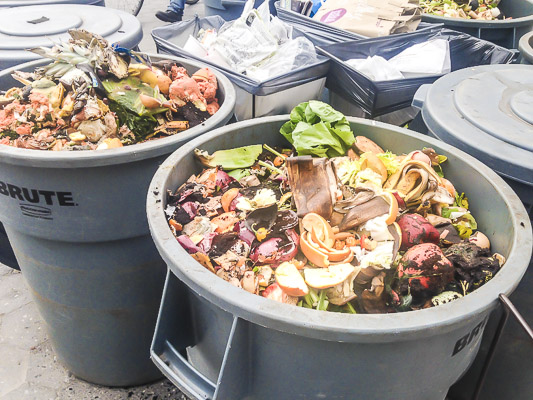Issues: Finding a food-scrap solution

Bins with fruit and vegetable peels, tea bags and dirt at the compost center at the GrowNYC Farmer’s Market at Union Square. Photo: Ayana Osson.
Cynthia Russell slowly walked up to one of 12 gray garbage bins filled with layers of onion peels, celery stalks and used tea bags. The bins were set in a semi-circle, a small compost center for the GrowNYC farmer’s market at Union Square. She clutched her dog Magnolia’s leash in one hand and a large bag filled with food scraps she’d saved in the other.
“It doesn’t make sense to fill up the landfills,” said Russell, 37, a yoga instructor who started saving her organic food waste for compost a year ago.
This compost center, run by the Lower East Side Ecology Center, is one of 38 centers that have popped up throughout the city since the center opened in 1994. Though the composting center at Union Square is the only center that Lower East Side Ecology runs at a farmer’s market, they have expanded to four other commuter drop-offs and centers in community gardens. The others are run by different organizations.
Andrew Hoyles, a project manager for the center’s NYC Compost Project, said that the center focuses on composting organic matter and reducing electronic waste to help create a sustainable environment. According to Hoyles, each person generates between four and six pounds of organic waste daily, things like “banana and orange peels.”
One city council member has proposed charging residents for their trash. Andrew Reynoso, who represents Williamsburg and Bushwick in Brooklyn and part of Queens, is pushing for a pay-as-you-go trash system to cut waste costs and make people more aware of the waste they accumulate.
Reynoso’s garbage fee proposal calls for homeowners to separate their organic matter, like fruit peels or dried flowers, from their trash, and to pay a fine if they fail to do so. Though many New York residents agree that something needs to be done to reduce waste in the city, critics say it’s unfair to penalize people when composting is not an easy option for many.
“It’s a bad move for the government to charge people,” said Haim Mucktar, who drops off his food scraps to be composted at the farmer’s market three times a week. “What they have to do is make it easier, not for me to have to come all the way to the market. They should start doing this outside of buildings.” Still, Mucktar drops off his food scraps often, despite the inconvenience, and has been doing so for the past five years.
Benjamin Miller, former director of city planning for the Department of Sanitation, is in favor of charging people for not separating their organic matter from their trash, which can reduce waste sent to landfills by about 17 percent. He also thinks that the city’s long-term goal – diverting 75 percent of solid waste from landfills by the year 2030 as part of PlaNYC2030 – is achievable. The real issue, he says, is the city’s lack of efficient facilities.
Councilman Reynoso’s office was unavailable for comment.
In May the NYC Compost Project and Built It Green! NYC (BIG!), a non-profit building re-use and composting organization, will partner with the Department of Sanitation to collect organic material curbside in all five neighborhoods. The curbside pilot project, first launched last year, is part of the Department of Sanitation’s five-year plan to target all neighborhoods in the city.
“It’s still kind of a challenge to collect organic matter of a 50-story building,” said Ryan Olds, a field and project assistant for Build It Green! “But it is being actively worked on. The big part is educating people as to why they should compost, and a mind shift has to take place.”
Olds anticipates that once people learn that they should separate organic matter the process will become second nature, as it did with recycling.
At the moment, the city is struggling to keep up for demand for new composting projects. Russell, who lives in West Chelsea, said that she contacted the city in hopes of starting a composting center in her neighborhood, only to receive an automated reply that the system was too backed up to add centers to apartment buildings.
“I think the answer is to make it more accessible for people to compost,” said Russell. She suggests that this can be done by adding more compost centers to more neighborhoods.
The problem, no matter what the city does, is cost.
Miller says that the first step to reduce waste is to develop processing capacity — and that the city’s current method of sending waste to landfills contributes to greenhouse gas emission, and is very costly.
“Having different types of facilities that can handle food waste, like compost facilities and anaerobic incinerators, can be pretty sophisticated and expensive,” said Miller.
One food activist says that redefining waste would create less of it. Jordan Figueiredo is the founder of endfoodwaste.org and the online campaign Ugly Fruits and Veg, which raises awareness of produce waste through social media. He said that 20 to 30 percent of produce on farms is thrown away because it is bruised or otherwise unattractive to the consumer, even though it is perfectly good. Large groceries refuse to sell such produce, with the excuse that consumers will not buy it.
He also says that a lack of understanding of expiration dates contributes to food waste in the U.S. Many people think that food expires on its sell-by date, when it is still perfectly edible, but supermarkets take it off shelves and consumers throw it out, even though it may be good for weeks.
Produce waste is something that is not talked about enough, said Figueiredo.
Figueiredo realizes that reducing produce waste won’t change quickly, because educating people and getting large grocers to start selling less-than-perfect produce will take time.
“Part of it is our culture too,” he said.

Your Comments